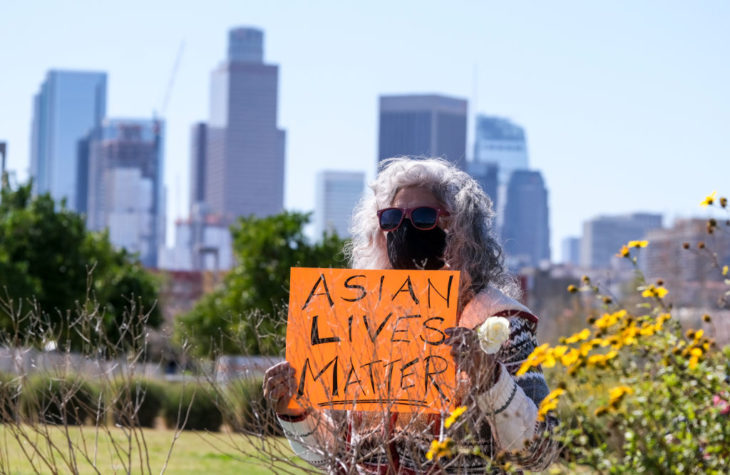
The same dynamics seems to be unfolding with the current spike in anti-Asian hate crimes. In a New York Times article, Univision anchor Jorge Ramos argued that both the wave of anti-Asian and anti-Latino hate crimes reflect the racism of white Americans. He noted, 'A common racist attack against the Latino community — and now increasingly, Asian Americans — is the demand, "Go back to your own country!"' Nancy Pelosi also links this spike to white supremacist views.
White supremacists should be vigorously combatted. However, most victimized groups live in central cities where there are few white supremacists. Members of the Asian, Latino and LGBTQ communities may have much more to fear from young alienated black men whose pent up anger spills over into destructive, violent behaviors.
Using 2019 FBI statistics — the most recently available data — I computed black and white perpetrators of hate crimes as a percentage of men 18 to 44 years old in their populations. The black rate was 40 percent, 76 percent and 303 percent higher than the white rate for hate crimes against the Asian/Pacific Island, Latino and LGBTQ communities respectively. Even more troubling, black rates for hate-crime assaults were 94 percent higher while for property destruction and vandalism, they were 14 percent lower than white rates.
Evidence from Los Angeles verifies the limited reach of white supremacist actions, particularly with regards to violent crimes and those perpetrated against Asian/Pacific Island, Latino, or LGBQT communities. Its Human Rights Commission found:
'After declining for two years, white supremacist crimes...accounted for 22 percent of all [2019] hate crimes. Seven out of 10 white supremacist crimes involved vandalism and more than half targeted persons from the Jewish community.'Disproportionate black behaviors extended to all violent crimes. For 2019, black arrests per male for murders and all violent crimes were, respectively, 4.94 and 2.73 times white arrests per male. And these numbers are before the unprecedented 2020 homicide spike.
In this environment, young black men are more likely to be exposed to an oppositional street culture; one that not only endorses violence as means of conflict resolution but contributes to a social environment where gun violence is common. The everyday occurrence of violence was documented by Ta-Nehisi Coates. In the first pages of his memoir The Beautiful Struggle he noted that five percent of the young people living in Baltimore's poorest areas ('1 in 21') were killed annually.
After studying Pittsburgh youth, Mark Berg noted, '[Many] decent youths adopted a violent public posture — even though it violated their own personal beliefs in conventional norms — in order to deter the aggressive overtures of other youths in their neighborhood.' Coates gives a vivid example. For a time he avoided fights: 'My style was to talk and duck.' But eventually he could not talk his way out of trouble. When hit in the face, he 'busted out crying'. Coates recounted: 'From then on, I was the weakest of the marks, and my weakness was despised. By the gifted kids, most of all.'
Even before the pandemic, there were a significant number of disconnected young black men. In 2018, 20.8 percent of black men aged 18 to 24 years old were neither at paid employment nor in school, more than double the white rate. Disconnected young people are about two-and-a-half times as likely to be living with family other than their parents and eight times as likely to be living alone as their more-connected peers. This is the population that is most at-risk of embracing a gun culture that victimizes other black Americans, as well as other groups.
Unfortunately, social justice advocates rationalize away these anti-social behaviors for fear that any sustained campaign would only promote blaming-the-victim beliefs. Instead, they characterize these perpetrators as victims so that rather than penalizing them for their behaviors, restorative justice procedures are championed. And following this perspective, many cities have dramatically adjusted their classification of crimes. Felonies are reduced to misdemeanors, misdemeanors are reduced to fines. With too aggressive bail reform that includes those found with illegal weapons, and prison diversion programs — violent-prone youth are allowed to remain on the street even after repeat offenses.
Most troubling, there is an unwillingness to combat family and school inadequacies that result in a large share of black 10-year-olds having significant academic and behavioral deficits. Without improving this situation, too many black boys will continue to enter high schools with significant shortcomings that lead them to end up in the disconnected population. Government must provide supportive resources for families, including visiting nursing programs and counseling services, and incorporate best practices that have enabled charter public schools to be much more effective than traditional public schools in educating poor black and Latino students. Only then can we limit the seeds of the violent behaviors that afflict many young black men.
Robert Cherry is a retired Brooklyn College economist and author of Why the Jews? How Jewish Values Transformed Twentieth Century American Pop Culture (Roman & Littlefield).



Comment: See also: